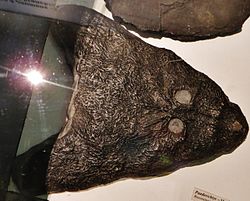Panderichthys
|
Panderichthys Temporal range: Late Devonian, 380 Ma |
|
|---|---|
 |
|
| Skull cast, Musee d'Histoire Naturelle, Lille | |
| Scientific classification | |
| Kingdom: | Animalia |
| Phylum: | Chordata |
| Class: | Sarcopterygii |
| Clade: | Tetrapodomorpha |
| Family: |
†Panderichthyidae Vorobyeva, 1968 |
| Genus: |
†Panderichthys Gross, 1941 |
| Type species | |
|
†Panderichthys rhombolepis Gross, 1941 |
|
| Species | |
|
|
Panderichthys is a genus of extinct sarcopterygian (lobe-finned fish) from the late Devonian period, about 380 Mya, of Latvia. Panderichthys, which was recovered from Frasnian (early Late Devonian) deposits in Latvia, is represented by two species. P. stolbovi is known only from some snout fragments and an incomplete lower jaw. P. rhombolepis is known from several more complete specimens. Although it probably belongs to a sister group of the earliest tetrapods, Panderichthys exhibits a range of features transitional between tristichopterid lobe-fin fishes (e.g., Eusthenopteron) and early tetrapods. It is named after the German-Baltic paleontologist Christian Heinrich Pander. A recent study uncovered tetrapod tracks dating back to before the appearance of Panderichthys in the fossil record, which suggests that Panderichthys is not a transitional fossil, but nonetheless shows the traits that evolved during the fish-tetrapod evolution
Panderichthys is represented by two different species: Panderichthys rhombolepis and Panderichthys stobolvi. P. rhombolepis was discovered by Gross in 1930 and P. stobolvi was discovered and figured by Emilia Vorobyeva in 1960. P. rhombolepis was discovered in Lode, Latvia within Frasnian deposits and according to P.E. Ahlberg can definitely be found in other Frasnian deposits in Latvia. Although fossils of Panderichthys have been known for a long time, but they have only recently been examined in full. The first time they were recognized as being phylogenetically closer to tetrapods than fish was by Shultze and Arsenault in 1985.
Panderichthys is a 90–130 cm long fish with a large tetrapod-like head that's flattened, narrow at the snout and wide in the back. The intracranial joint, which is characteristic of most lobe-fin fishes, has been lost from the external elements of the skull, but is still present in the braincase. The patterns of external bones in the skull roof and cheeks are more similar to those of early tetrapods than those of other lobe-fins. The transitional qualities of Panderichthys are also evident in the rest of the body. It lacks the dorsal and anal fins (fish fin) and its tail is more like those of early tetrapods than the caudal fins of other lobe-fins. The shoulders exhibits several tetrapod-like features, while the humerus is longer than those found in other lobe-fins. The vertebral column is ossified throughout its length and the vertebrae are comparable to those of early tetrapods. On the other hand, the distal parts of the front fins are unlike those of tetrapods. As would be expected from a fin, there are numerous lepidotrichia (long and thin fin rays).
...
Wikipedia
